Abstract
A vertex v is a peripheral vertex in G if its eccentricity is equal to its diameter, and periphery is a subgraph of G induced by its peripheral vertices. Further, a vertex v in G is a central vertex if , and the subgraph of G induced by its central vertices is called center of Average eccentricity is the sum of eccentricities of all of the vertices in a graph divided by the total number of vertices, i.e., If every vertex in G is central vertex, then , and hence, G is self-centered. In this report, we find the center, periphery and average eccentricity for the convex polytopes.
1. Introduction
In the facility location problem, we select a site according to some standard judgment. For example, if we want to find out the exact location for an emergency facility, such as a fire station or a hospital, we reduce the distance between that facility and the area where the emergency happens, and if we are to decide the position for a service facility, like a post office, power station or employment office, we try to reduce the traveling time of all people who have been living in that district. In the construction of a railway line, a pipeline and a superhighway, we will reduce the distance of the constructing unit for the people living in that area. All of these situations illustrate the concept of centrality but each of these three examples deals with different types of centers. Nowadays, centrality questions are being studied with the help of distance and graphs. We shall observe that many kinds of centers are helpful in facility location problems.
The most important and fundamental concept that extends to the whole of graph theory is distance. The distance is applicable in many fields, such as graph operation, extremal problems on connectivity, diameter and isomorphism testing. The theme of distance is used to check the symmetry of graphs. It also provides a base for many useful graph parameters, like radius, diameter, metric dimension, eccentricity, center and periphery, etc.
The eccentricity of the vertices in G has a fundamental importance. Recently, many indices related to eccentricity have been derived, i.e., eccentric connectivity index, adjacent eccentric sum index, Wiener index and eccentric distance sum [1]. The center and periphery is also based on minimum and maximum eccentricity, respectively. W.Goddard and O. R. Oellermann in [2] have shown that if G is an undirected graph, then,
They also examined the radius and diameter of certain families of graphs in the same paper, as follows:
- for
- if m and n is at least two,
- ,
This implies that complete graphs for , complete bipartite graphs where and all cycles are self-centered. Jordan [3] determined the diameter of a tree. Bela Bollobas [4] discussed the diameter of random graphs. The radius and diameter of a bridge graph are determined by Martin Farber in [5]. More general results were presented by V. Klee and D. Larman [6] and Bela Bollobas [4]. B. Hedman determined the sharp bounds for the diameter of the clique graph in terms of the diameter of G. The idea of self-centered graphs is presented and elaborated by Ando, Akiyama and Avis individually [7]. These self-centered graphs are extensively studied in [7,8,9,10,11]. The extremal size of a connected self-centered graph with p vertices and r radius is explained by F. Buckely [12]. The center in maximal outer planar graphs is demonstrated by A. Proskurowski in [13]. Hedetniemi [14] has shown that every graph is the center of some graph. The center of graph G is the full graph if and only if [15]. F. Buckely and F. Harary [16] gave the concept of average eccentricity. Average eccentricity is the sum of eccentricities of all of the vertices in a graph divided by the total number of vertices, i.e.,
The upper bounds of average eccentricity are determined by P. Dankelman, W. Goddard and C.S. Swart [17]. Average eccentricity is most important in communication networks. The average eccentricity of Sierpinski graphs is determined by Andreas, M. Hinz and Daniele Parisse [18]. Since 1980, the average eccentricity has had a great roll as a molecular descriptor in mathematical chemistry. This is attributed to V.A. Skorobogatov and A.A. Dobrynin [19]. For more details, please see [20,21,22] and the references therein.
Definition 1.
For a connected graph G, the eccentricity of a vertex v is its distance to a vertex farthest from v. Thus,
Definition 2.
The radius of G is the minimum eccentricity among all vertices of G.
Definition 3.
The diameter of G is the maximum eccentricity among all vertices of G.
Definition 4.
Average eccentricity is the sum of eccentricities of all of the vertices in a graph divided by the total number of vertices, i.e.,
Definition 5.
A vertex u is eccentric to a vertex v if .
Definition 6.
A vertex v is a peripheral vertex in G if its eccentricity is equal to its diameter, and periphery is a subgraph of G induced by its peripheral vertices. Further, a vertex v in G is a central vertex if , and the subgraph of G induced by its central vertices is called center of G. If every vertex in G is a central vertex, then , and hence, G is self-centered.
In the present report, we discuss the center, periphery and average eccentricity for families of convex polytope graphs, , and .
2. The Center and Periphery for Convex Polytope
In this section, we determine the center and periphery for convex polytope .
Definition 7.
The graph of convex polytope (double antiprism) can be obtained from the graph of convex polytope by adding new edges , i.e.,
Theorem 1.
For the family of convex polytope , , and Per are subgraphs induced by the vertices and , respectively.
Proof.
For all even values of n, select a vertex on the cycle . Then:
when , and for ,
In addition, for every value of i within to , must lie between and one, i.e.,
Thus, to find the vertices farthest from in , consider only .
For , consider the cycle . In this cycle, the distance between and is , and is adjacent to , therefore, the distance between and is .
Now, consider the cycle . The distance between and is and the vertex is adjacent to and adjacent to . It shows,
For , .
Hence, is a vertex farthest from .
Thus, the eccentricity of each vertex on inner cycle is .
In the same way, take cycle ; the distance between and in this cycle is,
Each is adjacent to and . Therefore,
For , consider the path . Then, the distance between and is . is also adjacent to . Therefore, the distance between and is as follows,
For , consider the cycle . The distance between and is . Further, is adjacent to and adjacent to . Therefore, the distance between and is .
Further, is also adjacent to and ; it follows from (3):
For , consider the cycle . The distance between and is , where is also adjacent to . Therefore,
Hence, , and are the vertices farthest from . Therefore:
Hence, each vertex on the middle cycle has eccentricity k.
Further, to find out the eccentricity of the vertices on the outer cycle , choose a vertex on this cycle. The distance between and is .
Each is adjacent to and , i.e.,
For , consider the path . The distance between and is . As is adjacent to , therefore, and has the following distance,
For , consider the cycle . The distance between and is . As is adjacent to and adjacent to , therefore, the distance between and is .
Each is also adjacent to and , using the result of (6),
For , consider the path . In this path, the distance between and is . is adjacent to and adjacent to . Therefore, the distance between and is .
For , consider the cycle . The distance between and is . is adjacent to , adjacent to and adjacent to . Therefore, the distance between and is .
This shows that is a vertex farthest from . Therefore:
Consequently, Cen is a subgraph induced by vertices , while the set of vertices is the peripheral vertices. Therefore, the periphery of is the subgraph induced by all of these vertices. ☐
Theorem 2.
For the family of convex polytope , n is odd.
Proof.
Consider, . Select vertex on the cycle . By using this,
while i increases from to , reduces from k to one.
Thus, to find the vertices farthest from in , we have to take only those values of i that lie between one and .
For , consider the cycle . In this cycle, the distance between and is , and is adjacent to . Therefore, the distance between and is .
Now, consider the cycle . The distance between and is . The vertex is adjacent to and adjacent to . It shows that the distance between and is .
For , .
Hence, and are the vertices farthest from . Therefore:
Thus, the eccentricity of each vertex on inner cycle is .
Similarly as above, the vertices and on cycle have the distance as,
Each is adjacent to and . Therefore,
For , consider the path . Then, the distance between and is . is also adjacent to . Therefore, the distance between and is , i.e.,
For , consider the cycle . The distance between and is . Further, is adjacent to , and is adjacent to . Therefore, the distance between and is .
Further, is also adjacent to and ; it follows from (10):
For , consider the cycle . The distance between and is . is also adjacent to . Therefore,
Hence, and are the vertices farthest from . Therefore:
Hence, each vertex on the middle cycle has eccentricity .
Further, to find out the eccentricity of the vertices on the outer cycle , choose a vertex on this cycle. The distance between and is .
Each is adjacent to and . Therefore,
For , consider the path . The distance between and is . As is adjacent to , therefore, the distance between and is .
For , consider the cycle . The distance between and is . As is adjacent to and adjacent to , therefore, the distance between and is .
Each is also adjacent to and , using the result of (13):
For , consider the path . In this path, the distance between and is . is adjacent to , and is adjacent to . Therefore, the distance between and is .
For , consider the cycle . The distance between and is . is adjacent to and adjacent to . In addition, is adjacent to . Therefore, the distance between and is .
This shows that and are the vertices farthest from . Therefore:
Consequently, (9), (11) and (14) show the smallest, In addition, the greatest eccentricity of these vertices is . Therefore:
Implies:
Hence, the family of is self-centered for odd values of n. ☐
2.1. Average Eccentricity for Convex Polytope
Here, we also are concerned with calculating the average eccentricity for the graph of convex polytope . The average eccentricity of any graph can be calculated by dividing the sum of the eccentricities of all of the vertices to the total number of vertices . There are three circles in the graph of convex polytope , and each circle consists of n vertices. Therefore, has a total of vertices; it follows,
By Theorem 1:
and by Theorem 2,
Therefore, we have the following result:
2.2. Illustration
Consider the graph of . We have labeled each of its vertices by its eccentricities. The center and periphery are shown in Figure 1 and Figure 2.
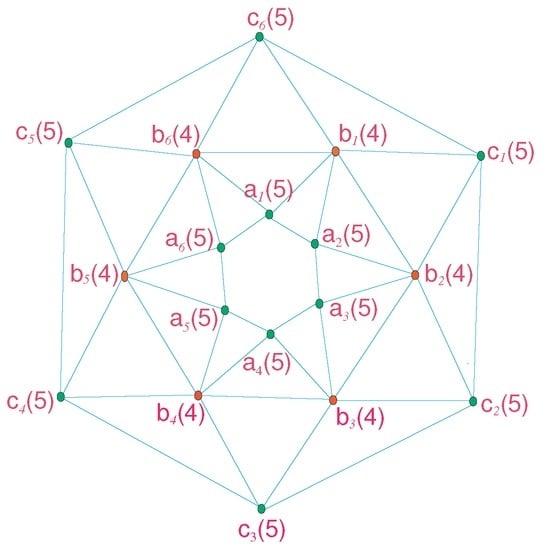
Figure 1.
The graph of convex polytope .
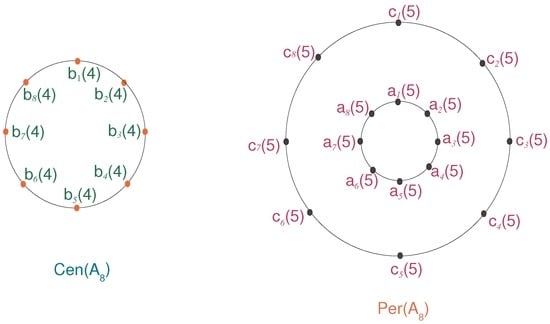
Figure 2.
Centrality in the graph of convex polytope .
3. The Center and Periphery for Convex Polytope
Here, we examine the center and periphery for convex polytope .
Definition 8.
The graph of convex polytope (double antiprism) can be obtained from the graph of convex polytope by adding new edges , i.e.,
For our convenience, we identify the cycle induced by the vertices , , and as the inner cycle, interior cycle, exterior cycle and outer cycle, respectively.
Theorem 3.
For the family of convex polytope , when n is even, we have:
Proof.
Suppose, , . Consider the cycle . Here, the eccentricity of only one vertex, i.e., , is determined, and due to the symmetry of the graph, all other vertices have the same eccentricity as on this cycle. Using this cycle,
For , varies from to one, i.e.,
Thus, to identify a vertex at maximum distance from in , take only .
As each is adjacent to , therefore,
For , take the interior cycle . In this cycle, the vertices and are at a distance . Further, is adjacent to and adjacent to . Therefore, The distance between and is .
Each is adjacent to and , by using (17),
For , consider the exterior cycle . The vertices and are at a distance . As is adjacent to and adjacent to , therefore, and are at a distance .
is also adjacent to , so (18) implies,
For , the vertices and are at a distance in the outer cycle . As is adjacent to , adjacent to and adjacent to , therefore, and are at a distance .
Therefore, .
In the same manner as above, we calculate the eccentricity of in the cycle . The distance between and in this cycle is,
and,
For , consider the cycle . The distance between and is . Since, is adjacent to . Thus,
Each is also adjacent to . Therefore, (20) shows,
For , consider the cycle . The distance between and is . As is adjacent to and adjacent to , therefore,
is also adjacent to , i.e.,
For , consider the cycle . The distance between the vertices and is . As is adjacent to , adjacent to , therefore,
As, and are farthest from therefore, . Next, the distance between and in the cycle is .
Additionally, for ,
Each is adjacent to , from (21):
For , the vertices and are at a distance in the cycle . The vertex is adjacent to and adjacent to . Therefore,
Each is adjacent to and ; Equation (17) implies,
For , and are at a distance in the path . Again, is adjacent to ; thus, we have:
For , consider the cycle . The distance between and is in this cycle. As, is adjacent to , adjacent to . Therefore,
Since is adjacent to , it follows from (22) that:
For , and are at a distance in the path . The vertex is adjacent to and adjacent to . Therefore,
For , the distance between and is in the cycle . is again adjacent to , adjacent to and adjacent to . For that reason,
Consequently, and are farthest from . Therefore, .
Next, take a vertex on the outer cycle. In this cycle ,
Additionally,
In addition, each is adjacent to ,
For , take a cycle . The vertices and are at a distance in this cycle. In addition, is adjacent to and adjacent to . Then,
Each is adjacent to and . i.e., and:
For , the vertices and are at a distance in the path . is adjacent to and adjacent to in . Therefore,
For , the vertices and are at distance in the cycle . is adjacent to , adjacent to and adjacent to ; for this,
In addition, is adjacent to . This implies from (25),
For , the vertices and are at a distance in the path . is adjacent to , adjacent to and adjacent to in . Therefore,
For , consider the cycle . The vertices and are at a distance in this cycle. is adjacent to , adjacent to , adjacent to and adjacent to . As a result,
Consequently,
Thus, it is concluded that maximum eccentricity among all of the vertices of is , and the minimum eccentricity is .
Therefore
☐
The following corollary is straightforward.
Corollary 1.
The center and periphery for the family of convex polytope , when n is even, are subgraphs induced by all of the central vertices and peripheral vertices of , respectively.
Now, we find out the radius and diameter of , when n is odd.
Theorem 4.
When n is odd, the family of convex polytope has the radius and diameter as,
Proof.
Let , . Consider the cycle , and select a vertex in it. It is clear that,
Thus, the equations above lead to the proof including only in order to find a vertex having the greatest distance from in . Since each is adjacent to , therefore, (27) implies that:
For , the vertices and are at a distance in the cycle . is adjacent to and adjacent to . Therefore, The distance between and is .
Again, each is adjacent to and , by using (28).
For , the distance between the vertices and is in the cycle . Since, is adjacent to and adjacent to , therefore, and are at a distance .
In addition, is adjacent to , therefore, (29) shows,
For , the vertices and are at a distance in the cycle . In addition, is adjacent to , adjacent to and adjacent to . Therefore, and are at a distance .
As a result, is farthest from ; therefore, .
In order to find out the eccentricity of the vertices on the cycle , the distance between and in this cycle is .
In addition,
Further, each is adjacent to and , therefore, (30) shows,
For , consider the cycle . The distance between and is . Since, is adjacent to , thus,
Each is also adjacent to . It is shown from (31),
For , consider the cycle . The distance between and is . As is adjacent to and adjacent to , therefore,
is also adjacent to , i.e.,
For , consider the cycle . The vertices and is . As is adjacent to , adjacent to , therefore,
Since, is a vertex farthest from therefore, .
Next, the distance between and in the cycle is,
Additionally,
Each is adjacent to , from (32):
For , the vertices and are at a distance in the cycle . The vertex is adjacent to and adjacent to . Therefore,
Each is adjacent to and ; Equation (28) implies,
For , and are at a distance in the path . Again, is adjacent to ; thus, we have:
For , consider the cycle . The distance between and is in this cycle. As is adjacent to and adjacent to , therefore,
Since is adjacent to , it follows from (33) that:
For , and are at a distance in the path .
The vertex is adjacent to , adjacent to . Therefore,
For , the distance between and in the cycle . is again adjacent to , adjacent to and adjacent to . For that reason,
Consequently, is a vertex farthest from . Therefore, .
Next, take a vertex on the outer cycle. In this cycle, ,
starts to decrease for as,
Each is adjacent to ,
For , take a cycle . The vertices and are at a distance in this cycle. In addition, is adjacent to and adjacent to . Then,
Each is adjacent to and , i.e., and
For , the vertices and are at a distance in the path . is adjacent to and adjacent to in . Therefore,
For , consider the cycle . The vertices and are . is adjacent to , adjacent to and adjacent to ; for this,
In addition, is adjacent to . Therefore, (36) implies,
For , the vertices and are at a distance in the path . is adjacent to , adjacent to and adjacent to in . Therefore,
For , consider the cycle . The vertices and are . is adjacent to , adjacent to , adjacent to and adjacent to . As a result,
This means,
It shows that the maximum and minimum eccentricity among all of the vertices of are and , respectively. Therefore:
☐
Thus, we can summarize the above results as,
Corollary 2.
The center for the family of convex polytope is a subgraph induced by all of the vertices of the interior and exterior cycles, and the periphery is the subgraphs induced by all of the peripheral vertices of , respectively.
3.1. Average Eccentricity for Convex Polytopes
Here, the average eccentricity for the family of is being determined. The graph of consist of four major circles, and there are n vertices in each circle. Therefore, the total number of vertices in (i.e., ) is ; it follows,
By Theorem 3:
and by Theorem 4,
Therefore, we have the following result:
3.2. Illustration
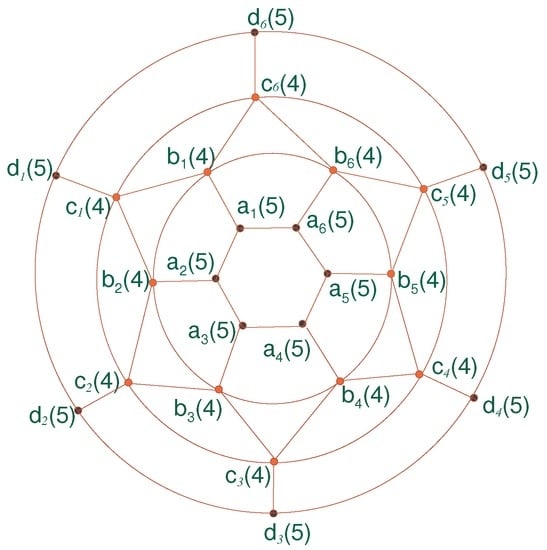
Figure 3.
The graph of convex polytope .
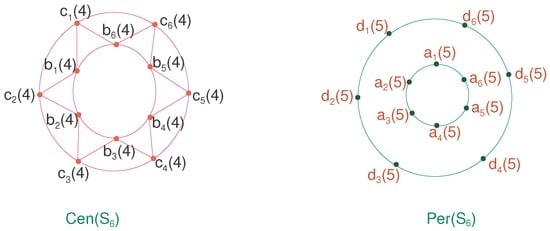
Figure 4.
Centrality for .
4. The Center and Periphery for Convex Polytopes
Here, we established the center and periphery for and show that is not self-centered.
Definition 9.
The graph of convex polytope can be obtained from the graph of convex polytope by adding new edges . It consist of three-sided faces, five-sided faces and n-sided faces. , i.e., and
This section begins with the following theorem on .
Theorem 5.
The diameter for the family of convex polytope is,
In addition, its radius,
Proof.
Consider, , . Choose take cycle . In this cycle:
For , the distance between and decreases from to one, i.e.,
Therefore, we must considered in order to find the distance of a vertex from a vertex farthest from it in .
In the graph of , each is adjacent to and ; thus, (38) implies,
For , the vertices and are at a distance in the cycle . In addition, is adjacent to . Therefore, The distance between and is .
Further, each is adjacent to and , using (39).
for , consider path . The distance between and is . Each is adjacent to and adjacent to . Therefore,
Next, for , consider the cycle . The vertices and are at a distance . Further, is adjacent to and adjacent to . Therefore,
is also adjacent to . Therefore, (40) implies
For , the vertices and are at a distance in the cycle . In addition, each is adjacent to , adjacent to and adjacent to ; therefore,
Hence, is a vertex at the largest distance from . Therefore, .
Next, continue this for cycle ; we choose a vertex , such that,
The distance between and decreases from to one, when i increases from to .
In addition, each is adjacent to and .
and when , consider the path . and are at a distance in this path, and is adjacent to ; therefore,
For , consider the cycle . The distance between and is . As is adjacent to and adjacent to , therefore,
In addition, is adjacent to and ; using (41), we have:
For , consider the path The distance between and is . Further, is adjacent to . In addition, is adjacent to . Therefore, the distance between and is .
Further, is adjacent to ; hence, (42) shows,
For , the vertices and are at a distance in the cycle . The vertex is adjacent to and adjacent to . Therefore,
Hence, is a vertex farthest from . Therefore,
Next, to find out the eccentricity of the vertices , take a vertex among all ’s, and each is adjacent to , , i.e.,
and when , consider the path . and are at distance , and again, is adjacent to ; thus, we have:
For , consider the cycle . The distance between and is in this cycle. As is adjacent to and adjacent to , therefore,
Moreover, is adjacent to and ; it follows from (43) that:
For , and are at a distance in the path . Furthermore, is adjacent to and adjacent to . Thus,
For , the distance between and in the cycle is , and is adjacent to , adjacent to and adjacent to . For that reason,
Again, is adjacent to . Hence,
For , the vertices and are at a distance in the cycle , and is adjacent to and adjacent to in . Therefore,
In order to find the distance between and , consider the path . The distance between and is i-2, and is adjacent to and adjacent to . Therefore,
For more values of i, begins to reduce as,
This means that , and are the vertices farthest from . Therefore, .
Now, we find the eccentricities of the vertices on the cycle . In this cycle,
For , the distance between and decreases from to one.
As adjacent to :
When i increases from to , the distance between and is in the cycle . In addition, is adjacent to and adjacent to . Thus,
As each is adjacent to , .
For , consider a path . and are at a distance , and is adjacent to and adjacent to in . Therefore,
For , consider the cycle . The distance between the vertices and is . is adjacent to , adjacent to and adjacent to ; for that reason,
In addition, is adjacent to and . Therefore, (46) implies,
For , the vertices and are at a distance in the path . Further, is adjacent to , adjacent to and adjacent to in . Therefore,
For , consider the cycle . The distance between the vertices and is . is adjacent to and adjacent to . Further, adjacent to and adjacent to . As a result,
This shows that is at the highest distance from . Therefore, .
Thus, it is concluded that the maximum eccentricity among all of the vertices of is , and is the minimum eccentricity. Therefore, diam = = .
For odd n, the proof is analogous to the case discussed above and omitted. ☐
Corollary 3.
The center of , when n is even, is the subgraph induced by the central vertices while the periphery is the subgraph induced by the vertices of inner and outer cycles.
4.1. Average Eccentricity for Convex Polytopes
There are four circles in the graph of , and each circle has n vertices. The average eccentricity for the graph of convex polytope can be found out by dividing sum of eccentricities of all vertices on each circle to its total number of vertices. Therefore,
By Theorem 5:
and by Theorem 5,
Therefore, we get the following immediate result:
4.2. Illustration
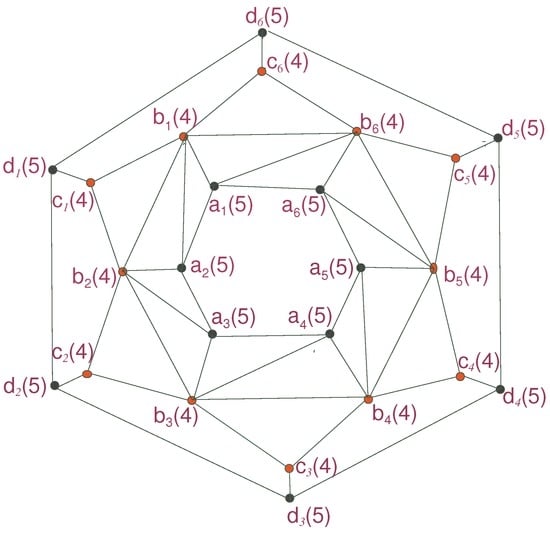
Figure 5.
The graph of convex polytope .
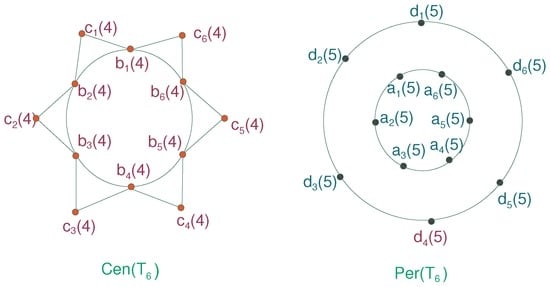
Figure 6.
Centrality for .
5. Concluding Remarks
In summary, we have studied the center and periphery of three types of families of convex polytopes via finding a subgraph induced by central and peripheral vertices. The predetermined facts about the eccentricity, radius and diameter of graphs play an important role in order to find the center and periphery for specific families of graphs; the average eccentricity of the above families of graphs has also been demonstrated.
6. Open Problems
This paper consist of the center and periphery for families of convex polytope graphs. This is an open problem for new researchers to find the center and periphery for others families of graphs, such as the corona product, composition product and lexicographic product of families of graphs.
Acknowledgments
This work was supported by the Dong-A University research fund, Korea.
Author Contributions
Waqas Nazeer, Shin Min Kang, Saima Nazeer, Mobeen Munir, Imrana Kausor, Ammara Sehar and Young Chel Kwun contributed equally to the writing of this paper. All authors read and approved the final manuscript.
Conflicts of Interest
The authors declare no conflict of interest.
References
- Yu, G.; Feng, L. On Connective Eccentricity Index of Graphs. MATCH Commun. Math. Comput. Chem. 2013, 69, 611–628. [Google Scholar]
- Goddar, W.; Oellermann, O.R. Distance in Graphs. Available online: https://people.cs.clemson.edu/goddard/papers/distanceChapter.pdf (accessed on 28 November 2016).
- Jorden, C.; Lignes, S.L.A.D.; Reine, J. Sur les assemblages de lignes. J. Ang. Math. 1869, 70, 185–190. [Google Scholar] [CrossRef]
- Bollobas, B. The Diameter of Random Graph. Trans. Am. Math. Soc. 1981, 268, 41–52. [Google Scholar] [CrossRef]
- Farber, M. On Diameters and Radii of Bridge Graphs. Discret. Math. 1989, 73, 249–260. [Google Scholar] [CrossRef]
- Klee, V.; Larman, D. Diameter of Random Graph. Can. J. Math. 1981, 33, 618–640. [Google Scholar] [CrossRef]
- Akiyama, J.; Ando, K.; Aavis, D. Miscellaneous Properties of Equi-Eccentric Graphs. In Convexity and Graph Theory (Jerusalem, 1981); Elsevier: North Holland, Amsterdam, 1984. [Google Scholar]
- Buckely, F. Self-centered Graphs. Ann. N. Y. Acad. Sci. 1989, 576, 71–78. [Google Scholar] [CrossRef]
- Buckely, F.; Miller, Z.; Slater, P.J. On Graphs Containing a Given Graphs as Center. J. Graph Theory 1981, 5, 427–432. [Google Scholar] [CrossRef]
- Janakiraman, T.N.; Ramanujan, J. On self-centered Graphs. Math. Soc. 1992, 7, 83–92. [Google Scholar]
- Negami, S.; Xu, G.H. Locally Geodesic Cycles in 2-self-centered Graphs. Discret. Math. 1986, 58, 263–268. [Google Scholar] [CrossRef]
- Buckely, F. Self-centered Graph With Given Radius. Congr. Number 1979, 23, 211–215. [Google Scholar]
- Proskurowski, A. Centers of Maximal Outer Planar Graph. J. Graph Theory 1980, 4, 75–79. [Google Scholar] [CrossRef]
- Hedetniemi, S.T. Center of Recursive Graphs; Technical Report CS-TR-79-14; Department of Computer Science, University of Oregon: Engene, OR, USA, 1979; p. 13. [Google Scholar]
- Chartrand, G. Introduction to Graph Theory; Tata McGraw-Hill Education: New York, NY, USA, 2006. [Google Scholar]
- Buckley, F.; Harary, F. Distance in Graphs; Addison-Wesley: Red Wood City, CA, USA, 1990. [Google Scholar]
- Dankelman, P.; Goddard, W.; Swart, C.S. The Average Eccentricity of a Graph and Its Subgraphs. Utilitas. Math. 1988, 65, 41–51. [Google Scholar]
- Hinz, A.M.; Parisse, D. The Average Eccentricity of Sierpinski Graphs. Graph Comb. 2012, 28, 671–686. [Google Scholar] [CrossRef]
- Skorobogatov, V.A.; Dobrynin, A.A. Metric Analysis of Graphs. MATCH. Commun. Math. Comput. Chem. 1988, 23, 105–151. [Google Scholar]
- Takes, F.W.; Kosters, W.A. Computing the Eccentricity Distribution of Large Graphs. Algorithms 2013, 6, 100–118. [Google Scholar] [CrossRef]
- Leskovec, J.; Kleinberg, J.; Faloutsos, C. Graph Evolution: Densification and Shrinking Diameters. ACM Trans. Knowl. Discov. Data 2007, 1, 2. [Google Scholar] [CrossRef]
- Kang, U.; Tsourakakis, C.E.; Appel, A.P.; Faloutsos, C.; Leskovec, J. HADI: Mining Radii of Large Graphs. ACM Trans. Knowl. Discov. Data (TKDD) 2011, 5, 8. [Google Scholar] [CrossRef]
© 2016 by the authors; licensee MDPI, Basel, Switzerland. This article is an open access article distributed under the terms and conditions of the Creative Commons Attribution (CC-BY) license (http://creativecommons.org/licenses/by/4.0/).